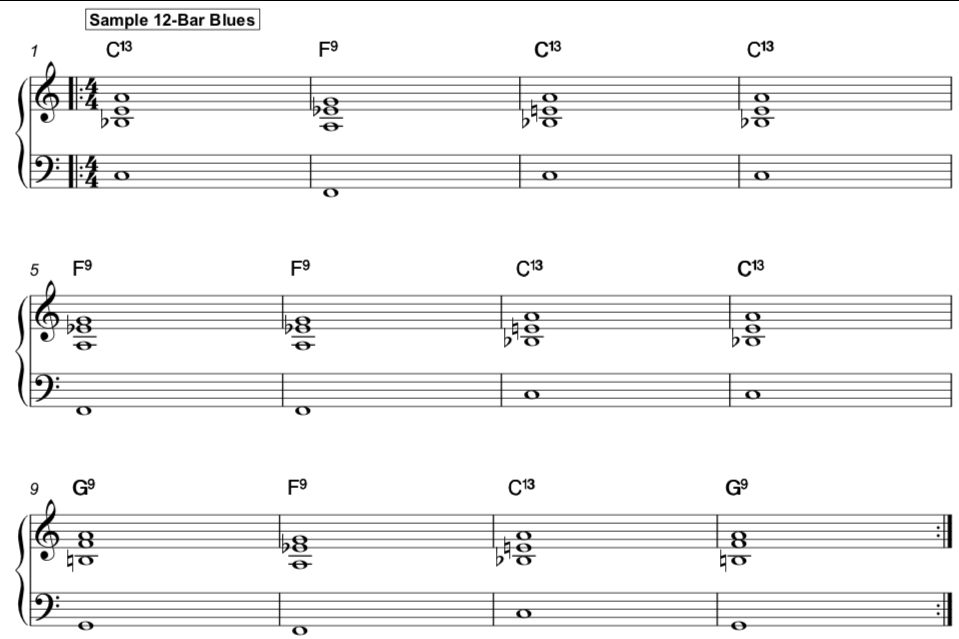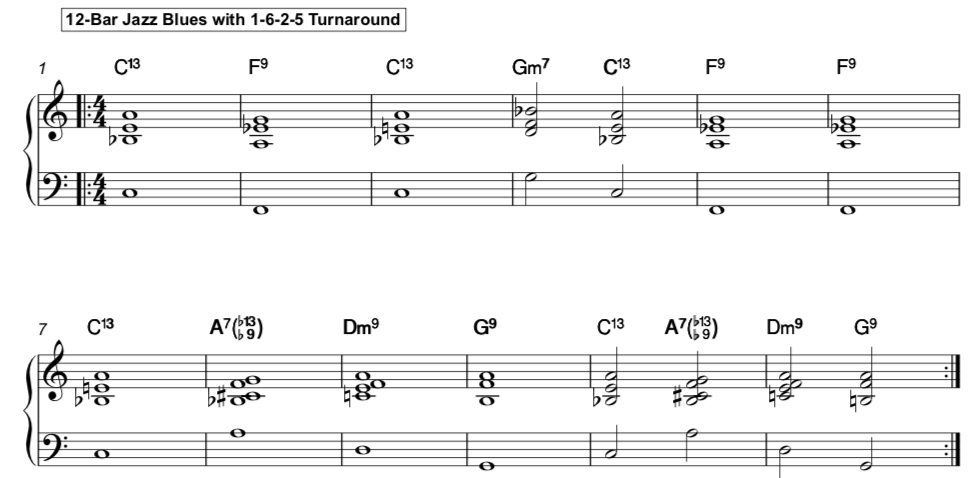Jazz Piano Chord Progressions: The Essential Guide
 Want to learn the must-know jazz piano chord progressions?
Want to learn the must-know jazz piano chord progressions?
You've come to the right place.
In this lesson, you will learn all the jazz chord progressions you need to learn the majority of jazz standard repertoire.
Learning these progressions also helps you learn how to improvise and compose your own tunes.
Let's get started.
1. What Is The Heart Of Jazz Chord Progressions?
The essence of jazz chord progressions is the same thing we find at the heart of tonal music.
This is the transition from I to V to I or V to I.
 jaz
jaz
We can also call this the tonic-dominant relationship, the I chord being the tonic and the V chord being the dominant.
Let me explain further.
 In tonal music (the basis of most contemporary music, including jazz), the I chord is considered to be consonant or stable while the V chord is dissonant or unstable.
In tonal music (the basis of most contemporary music, including jazz), the I chord is considered to be consonant or stable while the V chord is dissonant or unstable.
The way you create interest and meaning in music is that movement or progression from consonance to dissonance and back to consonance.
Every chord progression will follow this pattern at its very structure.
Let's take a stab at "Twinkle, Twinkle Little Star" as a simple example:

As you can see, the most basic way we harmonize any melody is through a cycle of I's and V's.
While none of these sound like jazz yet, all chord progressions essentially follow this very basic idea.
With a bit more patience, you'll see how this builds up in jazz chord progressions.
2. How To Say "Amen!" With Chords
Another rudimentary move you'll find is the plagal or "Amen" cadence. It's simply the IV-I chord progression or subdominant to tonic chord progression.

You can find it in tons of hymnals because this chord progression is used to accompany the singing of "A"(IV chord)-"men"(I).
 In certain styles of music, such as Gospel, holding on the IV chord (at a peak moment of a song), it gives room for vocal and instrumental improvisation.
In certain styles of music, such as Gospel, holding on the IV chord (at a peak moment of a song), it gives room for vocal and instrumental improvisation.
A variation of this chord progression is IV-iv-I i.e. a shift from a major subdominant chord to minor and then ending at the tonic.
Now that we have established how the V and IV chords can leadLet's look at another common chord progression in jazz.
3. How To Start Playing The Blues
The next chord progression we'll look at is the I-IV-V chord progression.
This chord progression is also common in blues, rock, and some pop music.
Here's what it looks like:

You would normally find the I-IV-V chord progression or some derivative of it various styles of music.
A 12-bar blues using the I-IV-V chord progression would look something like this on a chart:

 From a music theory perspective, this is the foremost example of a tonic-subdominant-dominant chord relationship.
From a music theory perspective, this is the foremost example of a tonic-subdominant-dominant chord relationship.
You can learn a great beginner level arrangement of "Blue Monk" through Zero To Jazz Piano Hero.
Zero To Jazz Piano Hero provides you everything you need to build a foundation for jazz as a beginner.
Get instant access to Zero To Jazz Piano Hero here.
Let's dig further into that concept called diatonic functions.
What Are Diatonic Functions?
 It's important for us to understand what diatonic functions are.
It's important for us to understand what diatonic functions are.
Why? It clarifies how chord functions are built.
Jazz chord progressions follows that tonic-subdominant-dominant relationship.
The tonic chord, being the I chord, is "home" or the tonal center of any given composition
It can either progress to any other chord or the chord that any unstable or tense chord will resolve to (such as the dominant or V chord).
The IV chord or subdominant chord can progress to any chord that functions as a dominant (V) or a tonic (I) chord.
 Lastly, the V chord will always transition to a chord that functions like a tonic (or I) chord.
Lastly, the V chord will always transition to a chord that functions like a tonic (or I) chord.
In any major or minor key, there are seven diatonic functions. The four others I haven't mentioned are the supertonic (ii), mediant (iii), submediant (vi), and leading tone (vii°).
However, practically speaking, those chords work either as tonic, subdominant, or dominant depending on the context of a composition. You will discover these later as we explore more chord progressions.
For more clarification regarding these roman numerals I use for chords, please go to our piano chord theory article here.
Now let's go and look at what I think is the most essential jazz chord progression of all time:
4. One Chord Progression To Rule Them All
If there's any one chord progression you need to master, it's the ii-V-I.
Some people would say that a lot of jazz songs are essentially ii-V-I's strung together.
Anyway, let's look at its basic structure here:

So what we have here is the ii chord as subdominant chord that resolves to V which then resolves to I.
Looking closely at the ii chord, the reason why it works as a subdominant chord is because of shared notes.
 In this example, a Dm7 chord has D-F-A-C as its notes. If you leave out the D, you are left with an F major triad, which is the actual subdominant in the key of C.
In this example, a Dm7 chord has D-F-A-C as its notes. If you leave out the D, you are left with an F major triad, which is the actual subdominant in the key of C.
If you look at plenty of jazz standards, ii-V-I chord progressions are all over the place.
Jazz standards such as Satin Doll, Don't Get Around Much Anymore, and Misty are filled with ii-V-I's.
As you will see in the next few chord progressions, they are all derivatives of ii-V-I's.
Let's dig deeper.
5. The Essential One Among Minor Jazz Chord Progressions
To convert your 2-5-1 into a minor jazz chord progression, you'll need to switch a couple of notes.
You just need to turn ii into a ii(b5) and the I to i but you keep the V the way it was before.
And so you're going to get something like this:

Some of the best examples where you can find this chord progression are the tunes "Autumn Leaves" and "Fly Me To The Moon".
What's The Best Tune To Learn For Essential Jazz Chord Progressions?
 The best way to cover both major and minor jazz chord progressions in a single package is to learn the tune "Autumn Leaves".
The best way to cover both major and minor jazz chord progressions in a single package is to learn the tune "Autumn Leaves".
This is because it essentially features a sequence of major and minor 2-5-1's across 32 bars.
And so, any decent jazz piano student should learn Autumn Leaves.
In fact, you can learn it in a couple of free lessons right here on the site.
The great thing is that you can even expand upon it via Premium Jazz Lessons.
Inside Premium Jazz Lessons, you can learn 3 solo piano arrangements of Autumn Leaves from beginner to advanced.
Sign up for Premium Jazz Lessons here.
Now that we've covered the fundamental jazz chord progressions, let's extend your skills even further.
6. The One Jazz Chord Progression That Links To The Classics
Ever heard of Doo Wop? Those tunes from the 50s? I suppose you know "Stand By Me"?
The thing is that some jazz songs use a similar chord progression. It's the I-VI-ii-V.

The best example where it's used is the tune "Don't Get Around Much Anymore".
The I-VI-ii-V is also a classic turnaround chord progression. Many blues and jazz blues tunes use this classic turnaround.
Check out this 12-bar blues with a I-VI-ii-V turnaround:

This chord progression is a variant of a classic I-vi-IV-V chord progression. This is what you find in classic hits like "Stand By Me".
Now that you have those basics, learn how to add more excitement through reharmonization techniques below.
7. Tritone Substitution Move: The bVI-V-I
 In music, a tritone is an interval a b5 above the reference note. For example, Ab is a tritone away from D.
In music, a tritone is an interval a b5 above the reference note. For example, Ab is a tritone away from D.
Just as a side note, it's called a tritone interval because the distance between D and Ab is exactly 3 whole tones away (D to E, E to F#/Gb, and Gb to Ab).
If you remember the ii-V-I from the previous chord progression, we're going to substitute the bVI instead.
It's going to work just like a ii or any subdominant functioning chord.

This particular chord progression creates a nice tension that takes the song slightly outside of the key.
Let's check out another tritone substitution move.
8. How To Chromatically Walk Down Towards The Key
In this next chord progression, we're going to go from ii then bII before landing on I.
So, in the key of C, we have something like Dm7-Dbmaj7-Cmaj7.

A common variant of this is a chromatic descent using dominant chords leading to the tonic.
For example, we can have D7-Db7-Cmaj7. This is a chord progression we see in a tune like Satin Doll.

Another great thing about this, especially when you're writing music, is that you can either use a minor, major, or dominant chord as your "1" chord. Let's talk about it more in the next section.
How Chord Substitutions Work
 When you decide on reharmonizing a tune, the only things you need to know are:
When you decide on reharmonizing a tune, the only things you need to know are:
- The substitute chord you're using should have at least one common chord tone with the former chord, including the melody note.
- This "reharm" should resolve nicely to the target chord.
If you look at every reharmonization example, it will always exhibit that dominant-to-tonic relationship.
We have more on that topic in our chord substitution lesson here.
Now let's go back and tinker around more chord progressions.
9. Why Always Enter At The Front When You Can Use The Backdoor?
 Another cool chord substitution trick is using the chord a minor 3rd above.
Another cool chord substitution trick is using the chord a minor 3rd above.
Check this out.
We have our ii-V-I in the key of C from earlier.
Let's say we mess around the ii and replace it with a tritone substitution so instead of Dm7 we have Ab7.
Now check this out: Instead of our G7 (V), let's replace it with a chord a minor 3rd above it and so we have Bb7 which is a bVII7 in the key of C.
So now we have Ab7 - Bb7 - Cmaj7.

This is what we call a backdoor chord progression. You see, in this case Bb7 is the backdoor to Cmaj7.
One variant I prefer is Abmaj7 instead of Ab7 since it reminds me of a Stevie Wonder or soul kind of vibe.
Let's check out another awesome jazz chord progression.
10. How To Add A 3-6 Move
Satin Doll is a tune that is a fantastic study for common jazz chord progressions.
In the beginning few bars of Satin Doll, you get a ii-V7.

The added twist is that the next chord progression is a iii-VI7

The way this works is that the iii chord is actually a substitute for the I chord. It functions in a similar manner, but because the iii chord doesn't have the root note of the key (in this case, C), it doesn't sound final.
 In fact, the iii chord, technically a mediant chord, will actually work like another subdominant that resolves to a VI7 chord.
In fact, the iii chord, technically a mediant chord, will actually work like another subdominant that resolves to a VI7 chord.
The VI7 chord then actually resolves back to the ii chord, allowing you to return to a ii-V-I or a II7-bII7-I in Satin Doll.
This is the kind of trick that allows you to create a chain of chord changes.
In fact in a number of jazz songs, you can use the 3-6 trick somewhere at the end of the tune to lengthen it or create climax.
Check out this example by Emmet Cohen performing "La Vie En Rose" where the end of the song features that 3-6 trick that creates some kind of hanging excitement near the end:
How To Get The Most Out Of Learning Jazz Chord Progressions
Here are the steps to really make the most out of this tutorial:
- Learn one chord progression at a time. I recommend starting from the very first example mentioned.
- Practice it in one key at first then learn it other keys until you can play it in all 12 keys.
- Listen to songs actively and identify chord progressions being used by ear.
- If you need help with some rudimentary music theory, consult our How To Read Music and Piano Chord Theory tutorials.
These chord progressions and techniques should allow you to get started into learning and understanding how to play jazz songs.
However, if you want to go even deeper, nothing beats getting guidance from a pro.
Why You Need A Jazz Piano Mentor
With all of these tutorials by jazz musicians floating around the web and on social media outlets like YouTube, Instagram, and TikTok, you might be wondering how can you straighten all of that. You've probably seen lessons and videos on everything from common jazz chord progressions, chord voicings, passing chords, minor chord, minor ii chord, chromatic bass line, diminished passing chords, minor key, extended chords, the ii v i, diminished chords, voice leading, major keys, flat major, sheet music for beginners, rhythm changes, using lead sheets, chords played by famous jazz pianists, jazz progressions you need to know, and so much more!
 It's a pain to try and filter all of that by yourself.
It's a pain to try and filter all of that by yourself.
Worse, all that mess floating around leaves you even more confused.
This is why you want guidance from someone who has actually has tested out everything on stage.
Fortunately, you now have the opportunity to receive mentorship from real world touring jazz piano professionals inside the Jazz Inner Circle.
Inside Steve's Inner Circle, you'll discover:
- Private 1:1 lessons with one of our FJL Certified Jazz Musicians
- "The Jazz Piano Mastery Program" (Over $25,000 worth of jazz piano training resources, tools, practice templates, improv strategies, & tons more.)
- "The Ultimate Jazz Piano Workout Training System." This is where we implement a complete practice program to build your jazz piano talent in record time.
Get one-on-one jazz piano training with us here.
Some Final Thoughts
I hope you enjoyed this lesson on jazz chord progressions. I hope that this boosts your jazz piano skills to another level.
If you have any comments, questions, or suggestions for another lesson topic, feel free to leave a note below.
Happy practicing.
Jazz Chord Progressions: More Piano Lessons
Quartal Harmony – The Ultimate Guide
Do you want to learn more about quartal harmony? You’ve come to the right place. In this lesson we’re going to show you 9 different ways you can use quartal harmony in your own playing. How to Play Quartal Chords Built in 4ths Take a minute and watch Steve break down some sweet quartal based…
Jazz Harmony: How To Learn Chords More Quickly
Got a great email question from Joe about how to make learning jazz harmony and jazz chords easier. “Hey Steve, Love your playing man! Ok, so I’ve played mostly rock in my life but I’ve always been a sucker for those jazzy chords. It’s time to finally up my chord game. I don’t have a million hours a…
Learn Piano: The 7 Most Popular Lessons on FJL in 2015
It’s that special time of year again! Welcome to the 3rd annual list of the 7 most popular free piano lessons of the year. This year was quite a special one. We saw record growth in so many ways: What We’ve Been Up To In 2015 I started this site in 2012. I started by throwing…
Jazz Harmony: Learn This Cool Chord Progression Trick
Would you like to learn more about jazz harmony? Want to learn a cool move you can use to spice up hundreds of the songs you play? Well, you’ve come to the right place! In today’s jazz harmony lesson I’m going to teach you a really tasty way you can reinvent the #1 chord progression in jazz.…
Learn Jazz Piano Comping
Would you like to improve your jazz comping skills? Want to learn some sweet jazz piano chords that you can use to comp over hundreds of jazz tunes? Well, you’ve come to the right place. In today’s free video lesson I’m going to show you how to play 3 tasty jazz comping voicing. Plus, I’ll…
Jazz Theory Cheat Sheet: The ii V I In All 12 Keys
As you continue to develop your jazz theory skills you’re going to want to make it a goal of being able to instantly play a ii-V-I chord progression in all 12 keys. Since you’ll hear the ii V I chord progression in so many great jazz tunes it’s vitally important that you learn how to play it quickly. It’s…
Jazz Theory Basics: The Secrets Behind The ii-V-I
Do you want to learn more about jazz theory? You’ve come to the right place! In today’s video lesson you’re going to learn how to build your jazz theory skills and you’re also going to learn about the #1 jazz chord progression. This lesson will open many doors for your music. Lets get started! Learn Jazz…
Learn Summertime: Easy Jazz Piano Tutorial
If you want to learn how to play jazz piano well it’s incredibly important that you invest some time into learning jazz standards. To help you get started building your repertoire I’m going to teach you how to play one of the most requested jazz standards of all time…George Gershwin’s Summertime. If you love the sound of George Gershwin’s…
Tritone Substitution – The Ultimate Guide
Check out this cool tritone substitution tutorial: In this video I’m going to teach you how to play a tritone substitution. We all know how important the II-V-I chord progression is to jazz music. It’s used in thousands of jazz standards. Now, it a beautiful sounding chord progression but sometimes in order to not sound…
How To Play A II-V-I-VI Chord Progression With Jazz Chords
Are you looking for information on the II-V-I-VI chord progression? Congratulations. You’ve come to the right place! There are tons of free lessons and articles on jazz and piano chords on this site. Make sure you bookmark this site and let’s get to learning! I also recommend you check out several of the other jazz…
4 Bill Evans Jazz Chords You Need To Know
Here’s a free jazz piano lesson featuring the awesome jazz chords of Bill Evans. This particular lesson features a ii-V-i-IV (2-5-1-4) chord progression in a minor key. These beautiful chords are very useful because you can use them in solo jazz piano arrangements and you can also use them to play behind other instrumentalists. They…
How To Play A Jazz Blues Chord Progression
In today’s free jazz blues chords lesson we’re going to take an in depth look at how to mix together some jazz chords and some blues piano chords into an incredible chord blend. This combo of jazz and blues piano chords will make your blues sound way more interesting. Players like Oscar Peterson, Wes Montgomery,…
